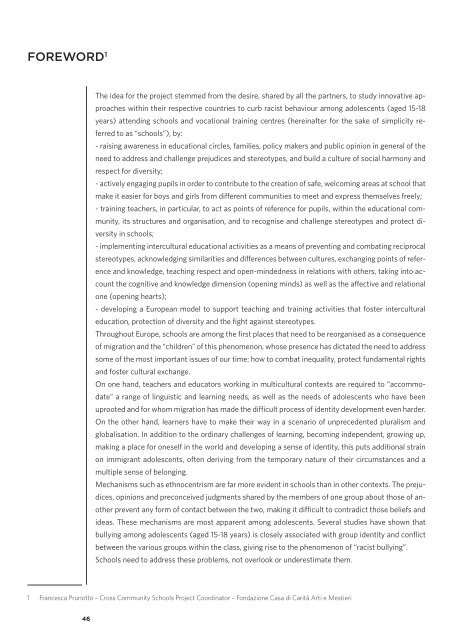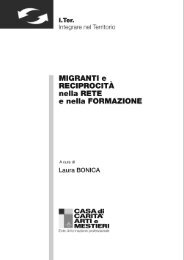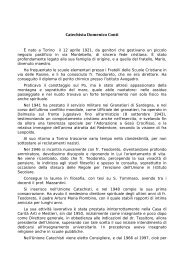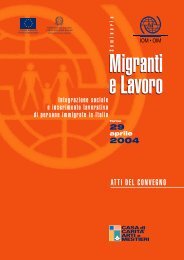Rapporto finale/ Final Report (ITA-ENG) - Casa di Carità Arti e Mestieri
Rapporto finale/ Final Report (ITA-ENG) - Casa di Carità Arti e Mestieri
Rapporto finale/ Final Report (ITA-ENG) - Casa di Carità Arti e Mestieri
You also want an ePaper? Increase the reach of your titles
YUMPU automatically turns print PDFs into web optimized ePapers that Google loves.
FOREWORD 1<br />
1 Francesca Prunotto – Cross Community Schools Project Coor<strong>di</strong>nator – Fondazione <strong>Casa</strong> <strong>di</strong> <strong>Carità</strong> <strong>Arti</strong> e <strong>Mestieri</strong><br />
46<br />
The idea for the project stemmed from the desire, shared by all the partners, to study innovative approaches<br />
within their respective countries to curb racist behaviour among adolescents (aged 15-18<br />
years) atten<strong>di</strong>ng schools and vocational training centres (hereinafter for the sake of simplicity referred<br />
to as “schools”), by:<br />
- raising awareness in educational circles, families, policy makers and public opinion in general of the<br />
need to address and challenge preju<strong>di</strong>ces and stereotypes, and build a culture of social harmony and<br />
respect for <strong>di</strong>versity;<br />
- actively engaging pupils in order to contribute to the creation of safe, welcoming areas at school that<br />
make it easier for boys and girls from <strong>di</strong>fferent communities to meet and express themselves freely;<br />
- training teachers, in particular, to act as points of reference for pupils, within the educational community,<br />
its structures and organisation, and to recognise and challenge stereotypes and protect <strong>di</strong>versity<br />
in schools;<br />
- implementing intercultural educational activities as a means of preventing and combating reciprocal<br />
stereotypes, acknowledging similarities and <strong>di</strong>fferences between cultures, exchanging points of reference<br />
and knowledge, teaching respect and open-mindedness in relations with others, taking into account<br />
the cognitive and knowledge <strong>di</strong>mension (opening minds) as well as the affective and relational<br />
one (opening hearts);<br />
- developing a European model to support teaching and training activities that foster intercultural<br />
education, protection of <strong>di</strong>versity and the fight against stereotypes.<br />
Throughout Europe, schools are among the first places that need to be reorganised as a consequence<br />
of migration and the “children” of this phenomenon, whose presence has <strong>di</strong>ctated the need to address<br />
some of the most important issues of our time: how to combat inequality, protect fundamental rights<br />
and foster cultural exchange.<br />
On one hand, teachers and educators working in multicultural contexts are required to “accommodate”<br />
a range of linguistic and learning needs, as well as the needs of adolescents who have been<br />
uprooted and for whom migration has made the <strong>di</strong>fficult process of identity development even harder.<br />
On the other hand, learners have to make their way in a scenario of unprecedented pluralism and<br />
globalisation. In ad<strong>di</strong>tion to the or<strong>di</strong>nary challenges of learning, becoming independent, growing up,<br />
making a place for oneself in the world and developing a sense of identity, this puts ad<strong>di</strong>tional strain<br />
on immigrant adolescents, often deriving from the temporary nature of their circumstances and a<br />
multiple sense of belonging.<br />
Mechanisms such as ethnocentrism are far more evident in schools than in other contexts. The preju<strong>di</strong>ces,<br />
opinions and preconceived judgments shared by the members of one group about those of another<br />
prevent any form of contact between the two, making it <strong>di</strong>fficult to contra<strong>di</strong>ct those beliefs and<br />
ideas. These mechanisms are most apparent among adolescents. Several stu<strong>di</strong>es have shown that<br />
bullying among adolescents (aged 15-18 years) is closely associated with group identity and conflict<br />
between the various groups within the class, giving rise to the phenomenon of “racist bullying”.<br />
Schools need to address these problems, not overlook or underestimate them.







